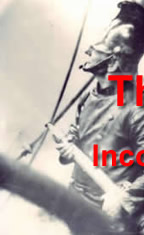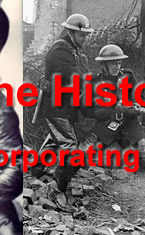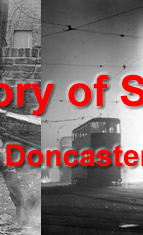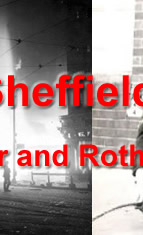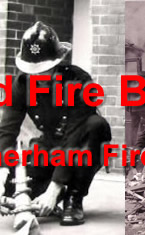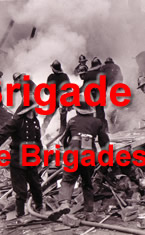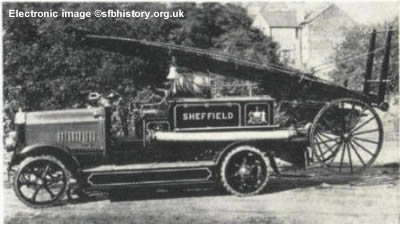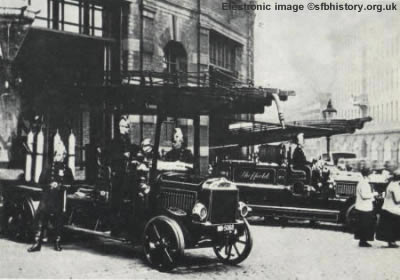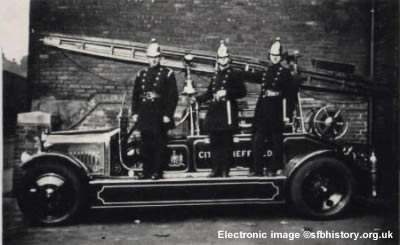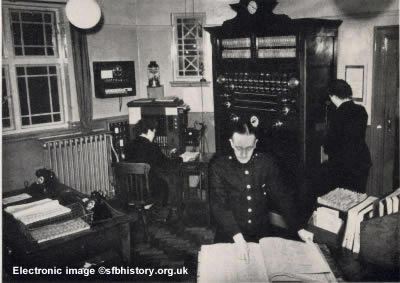
Tom Breaks was born in Bradford, Yorkshire in 1890, his father Thomas Breaks, aged 31, was from Bingley and was employed as a Fire Plug Inspector in Bradford. Toms mother Mary Ann, aged 32, was from Bristol. Tom had 3 sisters: Martha, age 11; Eliza Ann, aged 9; Hilda, aged 5. He also had an older brother Harry, aged 3, all the children were born in Bradford.
In 1901 Tom's father had now progressed to Superintendent in Charge of Sunderland Fire Brigade, and the family were now living at 16 East Cross Street, Sunderland, and Tom aged 10 had acquired a younger brother Frank, aged 7.
In 1911 the family, which now were now living at the Chief Fire Station, South Sherwood Street, Nottingham, and Tom's father Thomas was the Superintendent in charge of Nottingham Fire Brigade. At that time Tom aged 20, was employed as an electrical engineers apprentice.
On the 23rd September 1911, Tom married 19 year-old Alice Bradwell, the daughter of a retired policeman, at the Congregational Church, Gregory Boulevard, Nottingham. By this time Tom had followed in his father's footsteps and become a fireman. Between 1911 and 1914 the family were recorded as living at St Alban's Terrace, Nottingham, with their son Hector Thomas Breaks, born 28th November 1911.
On 27th May 1915, Tom, now living at the Fire Station, Guildhall Cottages, Nottingham, signed up in the army for the duration of WWI, and was posted to the Royal Army Service Corps. Following his enlistment, and training, he was posted to the R.A.S.C Ancillary Fire Service in Calais.
         |
| MT Depot, Calais, during World War I, where the Army Service Corps ran the first organized army fire brigade. The appliance shown was made by Henry Simonis & Co., of Willesden, London, who based their appliances on the Commer chassis. One of the first was supplied to the Base The 'Barnet' low-loading chassis was powered by a 4-cylinder petrol engine. |
Tom's daughter Doreen Alice Breaks was born on 15th March 1916, and on 20th May 1916, Tom was promoted to the rank of Corporal.
During his service in France he was mentioned in dispatches, and awarded the 'Croix de Guerre' by the French Government for his bravery at a fire caused by enemy shelling at Hazebrouck, in July 1917.
The citation read:
“Act of Courage – Corporal 106403 Breaks T., Hazebrouck 31/07/17. When the explosion of a shell had set a factory on fire , this N.C.O., rendered splendid service under conditions of considerable peril.”
On the 14th May 1918, whilst attending a fire at the premises of Monsieur Lamy, a bedroom wall collapsed on his injuring his head and back.
On the 19th February 1919 Tom demobilised from active service, and returned to serve as a Fireman in Nottingham Fire Brigade. His decorations were: WWI War Medal, WWI Victory Medal, and Croix de Guerre with Palm Leaf.
In the 1921 Census Tom was recorded as being a Sergeant in the Nottingham Fire Brigade. He and his family were recorded as all living at 13 Guildhall Cottages, Nottingham.
After 1921, It is thought that he progressed from a sergeant in Nottingham Fire Brigade to an inspector in the Salford Fire Brigade.
In April 1923 Tom Breaks was appointed Superintendent in charge of Sheffield Fire Brigade.
Superintendent Breaks was 33 when he was took up his appointment, however, he was full of enthusiasm to build up the Brigade which had inevitably run down through the war years, and because of the stringent economies necessary afterwards. Additional appliances were eventually obtained, and it was finally decided that a new Fire Station at Division Street was an important factor in the development of the Brigade.
Motor Pump, also carrying a 50ft Wheeled Escape |
1925 - Outside West Bar Fire Station. The fire engine in the foreground carries the gas operated 75 ft. turntable ladder previously carried on a horse drawn appliance, and originally purchased in 1903 |
          |
| Photograph researched and supplied by John Hague. Superintendent Breaks showing a party of native american indians, and film production staff, around Rockingham Street Fire Station in 1923. The American guests were appearing at the Albert Hall, Sheffield to publicise the film Covered Wagon which was released by Paramount Pictures in 1923 and directed by James Cruz. |
Sheffield Fire Brigade 1925
Photograph courtesy of the late Ronald Weston |
For years the firemen had been cramped for room in the old Rockingham street premises, not only in regard to the housing of appliances but for the actual accommodation of the men and their families. Many, in fact, had to live in quarters a long distance from the station, and whilst the new extension would not completely alter all this it would offers a great improvement.
The Rockingham Street premises were built in 1883-4, with accommodation for six horse-drawn engines, and were later adapted for motor vehicles. The housing accommodation consisted of the superintendent's house and flats for 20 firemen, superintendent's room, watch room, and hose tower.
To facilitate the extension to the Rockingham Street premises a row of shops fronting Division Street from Rockingham Street to Rockingham Lane was purchased and demolished, plans were prepared, tenders for the building were accepted.
1925 Sheffield Fire Brigade Establishment
View the 1925 Establishment (Opens on a new page)
1927 - The foundation stone for the extension of Central Fire Station is laid on Division Street
 |
The building work was undertaken by Messrs. Abbott and Bannister, Ltd., general builders and public works contractors, of Machon Bank, Sheffield, one of the best known building firms in Yorkshire. The firm had been established 37 years, and was equipped to carry out building contracts of all descriptions, large or small.
They had been responsible for many of Sheffield's public buildings, in addition to private houses and estate contracts. Besides Sheffield's new Fire Station, the firm had been responsible for the electric power station at Neepsend, the Council School at Maltby Street, the Secondary School at Nether Edge, the Employment Exchange alterations, Attercliffe, Globe Picture House alterations, Rivelin Filter House extension, and Millstone Inn, Hathersage.The design for the foundation raft was carried out by the Weston Concrete Engineering Co., Ltd.; of the Metropolitan Steel Works, High street, West Norwood, London, and the steel reinforcement was supplied and fixed by the designers, to the order of Messrs. Abbott and Bannister, Ltd.
The Weston Concrete Engineering Co. Ltd., were specialist designers and constructors of ferro-concrete, granolithic concrete and cement pavings. They are the patentees of the double layer "Trestle" and single layer "braced" fabric reinforcement.
G. W. Dawes and Son, of Hillsborough, Sheffield, were the plumbing contractor, whose workmanship was of the highest order. This firm had been successful in obtaining several large contracts, including super cinemas at Brighton and Birmingham.
The firm responsible for the stone work was Messrs. Joseph Turner, Ltd., of Middlewood Quarries, Oughtibridge, near, Sheffield. The firm had been in existence for over 100 years, and the stone in which they specialise had been used extensively by all the large works for heavy engine beds, and by all departments of the Sheffield Corporation for public buildings, including the old Town Hall Markets, Wicker Arches, several bridges, Ewden Valley Reservoir, Ingbirchworth Reservoir (Barnsley Corporation), and others.
The firm made a speciality of broken aggregate and had fulfilled many contracts.
Parnall and Sons, Ltd., of Waingate, Sheffield, the shop fitters, fitted up the premises. The firm, which had been established for 110 years, was to provide a unique feature in the Breeze metal torches, and the Breeze metal letters.
The contractors for the brick work were Messrs Robinson, of Park Works, Blagden Street, Sheffield, and the well-known "Stoke" stone was supplied by Messrs. Percy J. Turner, Ltd., quarry owners, Grindleford.
W. W. Fawcett, agents for the "Oakeley" Welsh slates, of Hale Street, and 157, Machon Bank, Sheffield, were the slating contractors. The firm had been engaged upon the Thornhill U.M. Church, and Holy Trinity Church Hall.
The plastering 'work was carried out by C. Outram, plastering and tiling contractor, of Wath road and Aizlewood road, Sheffield.
The contractors for the electrical equipment were W. E. Harrison, of Regent terrace, Sheffield, who installed the lightning conductors. The firm specialised in high structure repairs.
A feature of the flats is the sensible yet pleasant mode of decoration, and the firm responsible for this was Messrs. Bodsworth, of 416, London road, and 379, Abbeydale Road, Sheffield. The carving was carried out by Messrs. Frank Tory and Sons, Sheffield.
On the 11th July 1929 The new extension of Central Fire Station was officially declared open
          |
| Image courtesy of the late Dennis Kay |
11th July 1929 Sheffield's City Firemen make a brave display as they parade in front of the new Fire Station in Division street to form guard of honour for the Lord Mayor (Alderman H. Bolton), who, with the Chief Constable (Captain P. J. Sillitoe), and Councillor F. Thraves (chairman of the Watch Committee), inspected the parade before the ceremony of opening the new Fire Station, which was performed by the Lord Mayor.
(Leading the parade Superintendent T. Breaks, 2nd Officer from front Inspector A. Cornish, 3rd Officer Inspector J. Heyworth.)
There was a large crowd of people present for the ceremony, which was held in the engine room, including many members of the Watch Committee and Aldermen and. Councillors of the Sheffield City Council and Chesterfield Town Council.
Superintendent S. Breaks, the Fire Chief, was in charge of the arrangements.
Councillor F. Thraves, who presided at the opening ceremony, said the day was a memorable one so far as the Fire Brigade was concerned. The Watch Committee had not felt proud of the place that Fire Brigade was housed in for some years. Until the present building was erected the men and their families were housed in quarters which were certainly not creditable to the city.
The present building was commenced on 1 January, 1928. They would have liked a bigger and better site and better facilities for a quick turnout, but that was not possible having regard to the fact that they had to have the station in the centre of the city.
There was still a lot to be done, but he was sure when the Station was completed at a cost of £39,000 it would really be up to date. The quarters for the men and their families would be such that they could be proud of, and a recreation hall was provided for the men on and off duty.
Councillor Thraves paid a tribute to the spirit of the Fire Brigade staff from Superintendent Tom Breaks to the newest recruit to the Brigade. He thought it could be safely said that so far as the personnel of the Fire Brigade was concerned, they could congratulate themselves that they had a splendid body of men, both loyal and efficient, who always came out with credit to themselves and the city.
The Lord Mayor (Alderman H. Bolton) in opening the new building recalled the old days of the horse-drawn engines, and said that the City Council had long got in their programme the question of improving the Fire Station. The men were a body of workers of whom they could be proud, and he was glad to have the opportunity of opening their new premises.
Mr Sam Bannister, of the firm of Abbott and Bannister, the builders of the new premises, then presented Alderman Bolton with a silver rose bowl on behalf of his firm, and Superintendent Breaks with a silver fruit dish.
Councillor R. H. Minshall, proposing a vote of thanks to the Lord Mayor, said they were glad that at last they had been able to carry out what they ought to have done long ago.
Mrs. Longden seconded the vote of thanks, and Alderman A. Smith and Councillor Melling also spoke.
For years the firemen have been cramped for room in the old Rockingham street premises, not only in regard to the housing of appliances but for the actual accommodation of the men and their families. Many, in fact, have had to live in quarters a long distance from the station, and while the new extension will not completely alter all this it offers a great improvement.
The Rockingham Street premises were built in 1883-4, with accommodation for six horse-drawn engines and were later adapted for motor vehicles. The housing accommodation consisted of the superintendent's house and flats for 20 firemen, superintendent's room, watch room, and hose tower.
With the new extension the total area is 2,610 square yards, of which 2,000 square yards are built on. The new premises are designed and built with every modern improvement in fire fighting. Great attention has been paid to the facilities for getting the fire engines and men away to a call with the least possible delay.
Sliding poles of polished steel for the use of the firemen lead from all floors to the engine house, the doors of which open Division Street, and are fitted with a special quick-opening device.
The new buildings provide for heating chamber and battery room in the basement, on the ground floor an engine house 60ft. square for 10 engines, watch room and superintendent's offices, first and second officers’' quarters, 14 self-contained flats for firemen, and on the third floor a large recreation hall.
The whole structure steel lined with a concrete raft foundation and is fireproof.
Naturally, in a building like a Fire Station, it is necessary to link up the various rooms and offices with a reliable telephone system, and his has been done by New Systems Private Telephones, Ltd.
By the "round call' system, the depressing of a distinctive coloured button rings bells simultaneously throughout the premises, thus calling all the staff together with the least possible delay. The laryngaphone ensures good hearing amid loud and penetrating incidental noises.
The electric clock system of synchronised clocks was installed by Messrs. A. G. Burrell and Co., Ltd., electrical horologists, of Change Alley, Sheffield, who have linked up so many of the business premises in the Centre of Sheffield with their system of checking the time with Greenwich meantime.
The exterior landscape decorations and planning has been carried out by William Barron and Soul. of Elvaston Nurseries Borrowash, near Derby. The firm, which makes a speciality of the transplanting of large shrubs and trees, has carried out the work artistically, with the result that the outside appearance of the Fire-Station is very pleasing.
          |
| Photograph courtesy of John Hague Superintendent Breaks serves tea to his Inspectors. |
 Photograph from Sheffield Fire Brigade - A Brief History |
The fire engines of the Brigade about the period 1929 in the yard behind the new station in Division Street. In the background can he seen the old Rockingham Street Station. On the right of the photograph are the flats for married firemen and their families. The flats shown were part of the Rockingham Street fire station. |
Motor Fire Pump 1929 |
The new Brigade Control Room was opened at Division Street in 1929, and remained the Brigade's mobilising centre until 1953 when it was replaced by a new control room. |
          |
| Photograph researched and supplied by John Hague. The Inspection of Sheffield Fire Brigade at Niagara Sports Ground Wadsley Bridge. With Inspector J. Heyworth front left and Inspector Archie Cornish front right. Second from left in the rear rank, Fireman George Bellfield. |
1930: Firemen receive awards
Inspector Archie Cornish, Superintendent Tom Breaks received awards from Sheffield City Council fro their attempts to rescue Mrs Amanda Morton, aged 38 and her 2 year-old daughter Florence at the tragic Trafalgar Street Fire, on 16th January 1930.
 |
| Firemen: Left to Right - Inspector Archie Cornish; Superintendent Tom Breaks; Police Constable/Fireman William Gregory |
Sheffield Fire Brigade Inspector Seriously Injured at a Fire
On the 11th November, 1930, Inspector 'Archie' Cornish. Inspector Cornish suffered severe burns from a 'flash-over' fire caused by burning celluloid X-ray plates in the basement of the now demolished Royal Hospital.
At the time of the incident the Sheffield Royal Hospital Board made the following statement:
"The Board have appointed a committee for making full investigation into the cause of the fire, and they will report to the Board in due course. Mr. Booth, who received severe burns to his face and hands in a very plucky attempt to extinguish the fire, is making satisfactory progress, as is Inspector Cornish and an electrician, who was slightly injured.
"The Board are satisfied that the behaviour of the staff was most exemplary, and prevented panic. The whole thing was, over in a few minutes, and the prompt assistance of the Fire Brigade prevented what might have been a serious happening.
As a consequence of his injuries Inspector Archie Cornish, second officer of the Sheffield Fire Brigade, died 3 months later on the 18th February 1931 in the Northern Police Convalescent Home, Harrogate, from the effects of injuries received in the fire.
Archie's Funeral and Burial at Crookes Cemetery
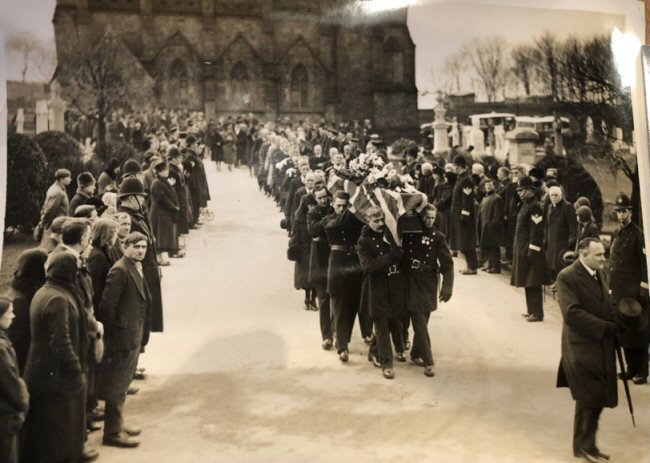 |
| Inspector Cornish's Funeral Cortege Leaves the Church Photograph courtesy of N. J. Kind |
At 2.20 p.m., the fire station alarm bell rang incessantly, symbolising the last call to the dead officer. The cortege, headed by a tender occupied by Superintendent T Breaks and Inspector Heyworth, moved slowly out of the station into Division Street, where several thousands of people had been congregated for some time.
Another engine bore the Archie's coffin and the bearers – comrades of the deceased; and other comrades occupied two more engines behind which bore scores of beautiful wreaths.
The family mourners occupied private cars, and other cars containing representative mourners formed the latter part of the procession.
 |
| Photograph courtesy of N. J. Kind |
On top of the large Union Jack which draped the coffin was the dead officer’s uniform – tunic, belt, helmet, and boots – which he was wearing when he received his injuries. Underneath the flag, and attached to the coffin lid, were his epaulettes, which were buried with him.
Archie was buried 23rd February, 1931 at Crookes Cemetery
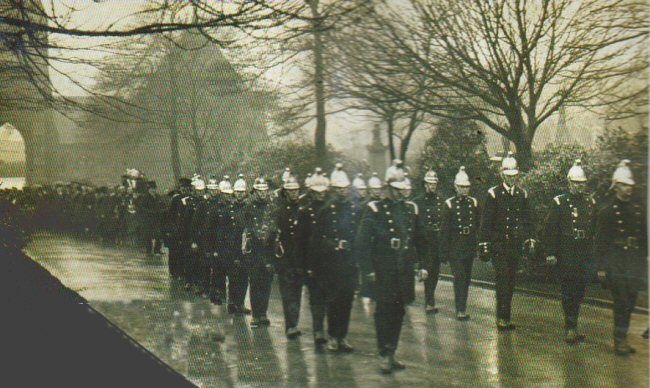 |
| The coffin enters Crookes cemetery |
Frederick Archibald Cornish (Archie) - Valediction
Archie was born in 1882 in Hessell, Suffolk. His father was Frederick Cornish, was from Rougham, Suffolk, and his mother Jemima Cornish was from Bury St Edmund's, Suffolk.
In 1891 Archie was living with his family at Combs, Stowmarket, and his father was a Farm Steward. By 1901 Archie was working as a Plumber's Apprentice at Stowmarket, Suffolk.
In 1911 Archie was recorded as working as a Police Constable/ Fireman in the Sheffield Fire Brigade under CFO/Superintendent Frost, and living at Flat 19, Rockingham Street Fire Station with his wife Annie Elizabeth from Hasland Chesterfield, whom he married in 1910.
By 1921 the Cornish family had increased by 3 children: Peggy Cornish age 9; Archie Cornish, age 6 and Grace Marjorie Cornish age 4.
By 1931 Archie had risen through the ranks to become an Inspector.
After his death his brass helmet, worn at the Royal Hospital fire, was adapted for use as a collecting box to receive donations for the the Fire Services National Benevolent Fund, and in 1933 the converted helmet was placed on a shelf outside the CFO's office in the Appliance Room at Division Street Fire Station, where it sat for many years. However, on a night in 1975, while the crews were out attending a fire call, the helmet was stolen and later found broken open near Barkers Pool.
The helmet was until recently on display in the entrance lobby at the West Bar Fire and Police Museum (Founded by members of the South Yorkshire County Fire Service, Historical Society).
April 1934
A coordinated Fire Service throughout the Country was being considered, and the first real step towards this was made in Sheffield.
This was the North Derbyshire Joint Fire Brigade Scheme in which the Fire Stations at Sheffield, Rotherham, Dronfield, Chesterfield, and Bakewell took part.
It was a start on the right lines, but unfortunately, it was hampered by lack of funds.
1933 Sheffield Fire Brigade Diving Equipment
 |
| The newly acquired Diving Equipment demonstrated in Division Street Yard - Photograph and research courtesy of Nigel Kind |
 |
| Diving equipment in use at a later date - Photograph and research courtesy of John Hague |
May 1934
          Photograph courtesy of Ron Henderson |
Known affectionately as The Pig, this Dennis Rescue Tender was bought by the Sheffield Police Fire Brigade in May 1934 at a cost of £696. Fitted with a first aid pump and hose-reel, and Ajax 35 foot ladder, and an 3.5 Kn dynamo and switchboard. Rescue Tender saw service throughout World War Two. Other equipment included: |
24th March 1936
Sergeant W. H. Gregory was awarded the National Equine League Bronze Medal for dangerous and dexterous work in successfully lifting 2 horses, which had fallen into a disused 20 foot deep gravel pit at Stannington.
 |
April, 1937
CFO Breaks was seconded to the Home Office, and was attached to the newly formed Fire Brigades Division as an Inspector of Fire Brigades.
Watch Committee Report April 1937:
Consequent on the departure of Superintendent T. Breaks, Chief of the Sheffield Fire Brigade, who has now an appointment under the Home Office, in London It is recommended by the Watch Committee that Chief Inspector C. Teather be Acting Superintendent, and Inspector Singleton, Acting Chief Inspector from April 19th last.
It is further recommended that Sergeant Marshall be Acting Inspector, and Fireman Jeffrey be Acting Sergeant, from July 1st last.
Chief Inspector Teather has been a member of the Sheffield fire Brigade for 24 years he was made a Sergeant in 1929, and on the retirement of inspector J. Heyworth, in 1934, he was appointed Second Officer, Since September last he has been Chief Inspector, A new rank created b the Watch Committee.
| CITY FIRE BRIGADE PROMOTIONS |
| Chief Inspector Teather to Acting-Superintendent |
Consequent on the departure of Superintendent T. Breaks, Chief of the Sheffield Fire Brigade, who has now an appointment under the Home Office, in London, it is recommended by the Watch Committee that Chief Inspector C. Teather be Acting Superintendent, and Inspector Singleton, Acting Chief Inspector from April 19th last.
It is further recommended that Sergeant Marshall be Acting Inspector, and Fireman Jeffrey be Acting Sergeant, from July 1st last.
Chief Inspector Teather has been a member of the Sheffield fire Brigade for 24 years he was made a Sergeant in 1929, and on the retirement of inspector J. Heyworth, in 1934, he was appointed Second Officer, Since September last he has been Chief Inspector, A new rank created by the Watch Committee.
On 3rd April 1937 the Sheffield Telegraph paid the following tribute to Superintendent Breaks:
| Sheffield Fire Chief Leaving To Take Up Work of National Importance OUTSTANDING CAREER Some Remarkable Feats Recalled |
Superintendent Tom Breaks head of the Sheffield Fire Brigade, who has an international reputation as a fire chief, is shortly to leave the city, having been offered an appointment at the Home Office in connection with Fire Brigade matters.
Subject to the approval of the City Council, next Wednesday, he will take over his new duties on April 19th, after 14 years in charge of the Sheffield Fire Brigade, which he has made second to none in efficiency.
His duties at the Home Office will be to assist in the reorganisation of the British fire services on a national scale - a scheme in accordance with the recommendations of the Riverdale Committee which was appointed last year by the Government to inquire into the fire brigade services of the country under the chairmanship of Lord Riverdale. Superintendent Breaks was one of the witnesses who gave evidence before this committee.
At present the fire brigades of the country are of a purely local character, but it is proposed that they should receive the recognition of the Government, in a similar manner to the police service, and that local authorities should receive from the Exchequer a grant in their support.
Although Mr. Breaks will carry out his work from London, he will, in the course of his duties, pay periodical visits of inspection to the various fire brigades throughout the country.
| A Notable Career |
During the past 14 years he has attended nearly 10,000 fires in Sheffield - an average of 700 a year - and although most of them have been small this is, in itself, a tribute to the work of the Fire Brigade.
Some of them, however, have been fires of exceptional severity at which Superintendent Breaks distinguished himself by his cool resource, his outstanding personality and his remarkable powers of organisation in an emergency. On several occasions he has saved life at fires.
Apart from actual fire-fighting work his services have been found invaluable in many spectacular emergencies, perhaps the best known was the capture of a tiger in the basement of the Empire Theatre, some years ago.
| Some Outstanding Episodes |
Other outstanding episodes in his Sheffield career have been:-
- The rescue of horses from a ganister pit in Stannington;
- His adventures on a raft, leading to the recovery of a body, in a gas holder in Arundel Lane, where a man had been drowned;
- A descent in a diving suit into a 30-foot well at Rotherham, after three children had been drowned.
- National recognition of his important work in the profession was shown by his election as president of the Institution of Fire Engineers, and he is also chairman of the Governing Council of the Professional Fire Brigades’ Association.
- He has been awarded the gold medal and diploma of the French National Office of Scientific Research and Invention, and is a Member of Honour of the French and Belgium Fire Brigade Federations.
- On four occasions he has been awarded the silver medal of the Society for the Protection of Life from Fire, for personal gallantry at fires, and he holds the Certificate of Honour of the Professional Fire Brigade Association for life saving.
- He has also been awarded the silver medals of the Royal Society for the Prevention of Cruelty to Animals and the National Equine Defence League for saving animal life.
| Tribute to his Men |
It is not yet known who will succeed Superintendent Breaks as head of the Sheffield Fire Brigade, but his deputy Chief Inspector Teather, will be in charge of the fire station for the time being.
Tribute to the loyalty and devotion to duty of the officers and firemen of the Sheffield Fire Brigade was paid by Superintendent Breaks in an interview yesterday, with a representative of the “Sheffield Telegraph.”
“They have at all times stood by me and assisted me in times of stress, danger and discomfort” he said.
“A fire brigade is not judged by its buildings, its machines, and apparatus, but by the quality of its men, and in Sheffield, we have the right men, all doing a real “man’s job.”
“Some of the happiest years of my life have been spent in Sheffield. The public have supported me, and if it is the wish of the City Council that I should be allowed to serve an even greater public. I shall enter into my new life with enthusiasm and endeavour to place the fire brigade services of the country on a sound footing.”
Mr. Breaks was a well known character in the City and attended many fires and special service calls. Perhaps the most notable of these was his capture, single handed, with the use of a 'Salvage Sheet', of a tiger which had escaped from its cage on the stage of the Empire Theatre, and after seriously mauling its keeper took refuge in a cellar beneath the stage.
Whilst much play has always been made of the part Superintendent Breaks played in the capture of the Tiger at the Empire Theatre. The reader might like to consider the report that is included in the 'News Pages' for this period.
